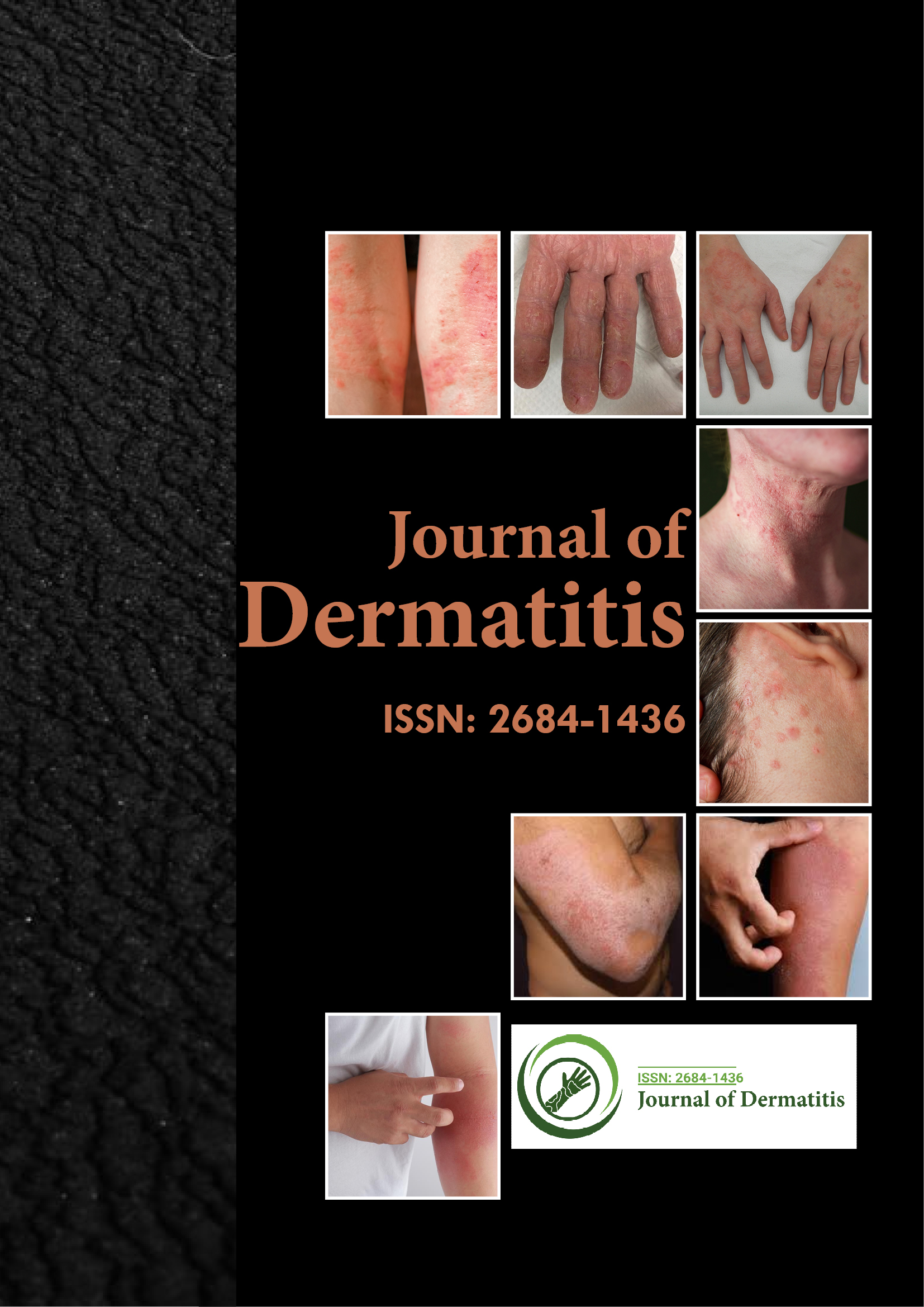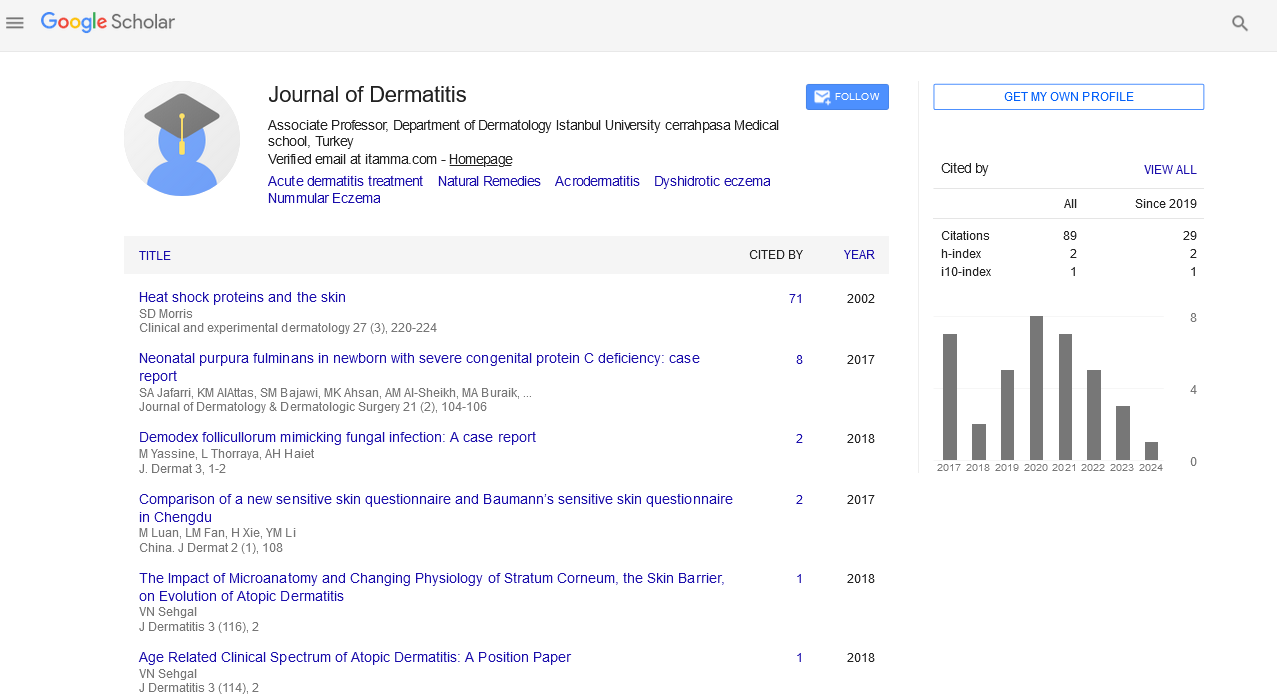Indexed In
- RefSeek
- Hamdard University
- EBSCO A-Z
- Euro Pub
- Google Scholar
Useful Links
Share This Page
Journal Flyer

Open Access Journals
- Agri and Aquaculture
- Biochemistry
- Bioinformatics & Systems Biology
- Business & Management
- Chemistry
- Clinical Sciences
- Engineering
- Food & Nutrition
- General Science
- Genetics & Molecular Biology
- Immunology & Microbiology
- Medical Sciences
- Neuroscience & Psychology
- Nursing & Health Care
- Pharmaceutical Sciences
Commentary - (2024) Volume 9, Issue 4
Managing Occupational Contact Dermatitis: Pathophysiology and Treatment Strategies
Ling Xiu*Received: 29-Nov-2024, Manuscript No. JOD-24-28248; Editor assigned: 02-Dec-2024, Pre QC No. JOD-24-28248 (PQ); Reviewed: 16-Dec-2024, QC No. JOD-24-28248; Revised: 23-Dec-2024, Manuscript No. JOD-24-28248 (R); Published: 30-Dec-2024, DOI: 10.35248/2684-1436.24.9.248
Description
Occupational Contact Dermatitis (OCD) is a common occupational skin disorder caused by exposure to harmful substances in the workplace. It represents a significant health burden, particularly for individuals in industries such as healthcare, construction, manufacturing and cleaning, where frequent exposure to irritants and allergens is prevalent. OCD is classified into two main types: Irritant Contact Dermatitis (ICD) and Allergic Contact Dermatitis (ACD). These forms of dermatitis differ in their fundamental pathophysiology, clinical presentation and management strategies, making accurate evaluation and individualized treatment essential for effective management.
The pathophysiology of Irritant Contact Dermatitis (ICD) involves direct damage to the skin barrier by physical or chemical irritants. These irritants can be acute or cumulative in nature, with substances like detergents, solvents, acids and alkalis often being culprits. The skin’s response to these irritants typically results in redness, dryness and peeling, particularly in areas of frequent exposure, such as the hands. ICD is often nonimmunological and typically develops quickly upon initial or repeated exposure to a specific irritant.
Alternatively, ACD is a delayed-type hypersensitivity reaction mediated by the immune system. ACD occurs after sensitization to a specific allergen, which could include substances such as nickel, latex, perfumes, or certain chemicals found in personal protective equipment. The clinical presentation of ACD includes erythema, vesiculation and edema, often with a more localized distribution that correlates with the site of exposure. Unlike ICD, ACD does not develop immediately but can occur several hours or days after exposure to the allergen.
Diagnosing OCD requires a comprehensive evaluation, which includes obtaining a detailed occupational history and identifying potential factors. A thorough history should assess the type of work performed, substances encountered and the duration of exposure. For example, healthcare workers might be exposed to latex, antiseptics, or gloves, while workers in the construction industry could come into contact with cement, solvents and cleaning agents. Identifying the exact irritant or allergen involved is essential for effective management and prevention.
Patch testing is the standard for diagnosing allergic contact dermatitis. This test involves applying small amounts of suspected allergens to the skin and observing for a delayed hypersensitivity reaction. For irritant contact dermatitis, however, a patch test is not applicable and diagnosis is based on clinical evaluation and the exclusion of other dermatological conditions.
Once the diagnosis is made, managing OCD requires a comprehensive approach, with an emphasis on both prevention and treatment. The foundation of management is avoidance of the offending irritant or allergen. In some cases, this may involve modifying work practices or the use of Personal Protective Equipment (PPE) to reduce exposure. For example, workers exposed to water and detergents should be encouraged to wear waterproof gloves, while those in environments with chemical exposure should use gloves resistant to solvents and chemicals.
In addition to protective measures, effective skin care is a key component of management. Regular use of emollients helps restore the skin barrier and prevent the development of irritant dermatitis. Patients should be educated on proper skincare routines that include the use of fragrance-free moisturizers, as well as gentle cleansing agents that do not strip the skin of its natural oils. In some cases, topical corticosteroids may be prescribed to reduce inflammation and alleviate symptoms of dermatitis, particularly in cases of allergic contact dermatitis or more severe irritant dermatitis.
For patients with severe or chronic OCD, systemic treatments may be necessary. Oral corticosteroids can be used in the short term to control extensive inflammation, but prolonged use should be avoided due to potential side effects. Other systemic immunosuppressive agents, such as methotrexate or cyclosporine, may be considered for individuals with refractory or severe ACD. Phototherapy is another option for patients with chronic or persistent dermatitis, particularly for those with extensive skin involvement.
In conclusion, occupational contact dermatitis is a prevalent condition that presents significant challenges to both workers and employers. Its management requires early recognition, accurate diagnosis and a comprehensive approach that includes both preventive measures and therapeutic interventions. Understanding the differences between irritant and allergic forms of OCD is essential for tailoring treatment strategies and achieving the best outcomes. By promoting workplace awareness, improving skin care practices and providing effective treatment, it is possible to reduce the incidence and impact of OCD, leading to healthier workers and improved workplace productivity.
Citation: Xiu L (2024). Managing Occupational Contact Dermatitis: Pathophysiology and Treatment Strategies. J Dermatitis. 9:248.
Copyright: © 2024 Xiu L. This is an open access article distributed under the terms of the Creative Commons Attribution License, which permits unrestricted use, distribution, and reproduction in any medium, provided the original author and source are credited.

